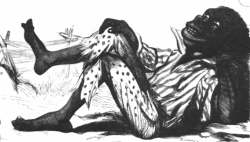The problem:
"All of a sudden you have entire peoples seen as sub-human; if someone is sub-human then the slaver is justified in what he does.
Two of the most provocative areas for legacy theory are the caricatures of black male sexual prowess and sporting achievement. The suggestion is that today's stereotypical images were born out of slave owners' preference for the most athletic specimens from among their stock.
Two centuries of these stereotypes and pseudo-science have arguably left a deep psychological scar on society--both in white perceptions of black people and the responses of some black people to that projection.
Now we celebrate them as warriors and mystics. Which means we still don't treat them as real people with real problems. We're happiest when they exist only in the fantasyland of movies, cartoons, and sporting events.



3 comments:
Slavery in the Americas began when Columbus arrived. It wasn't connected to any war. Rather, it was connected to Christendom's need to dominate and rule, whether by military or political means.
The Euro-American model is a knight or cowboy. See Why Write About Superheroes? and America's Cultural Mindset for more on the subject.
Related postings include "Dominate" Goes Way Back and When Did Racism Begin?
I was talking about the slavery initiated by Europeans in the Americas, obviously. In case you forgot, that was the subject of the original article.
Post a Comment